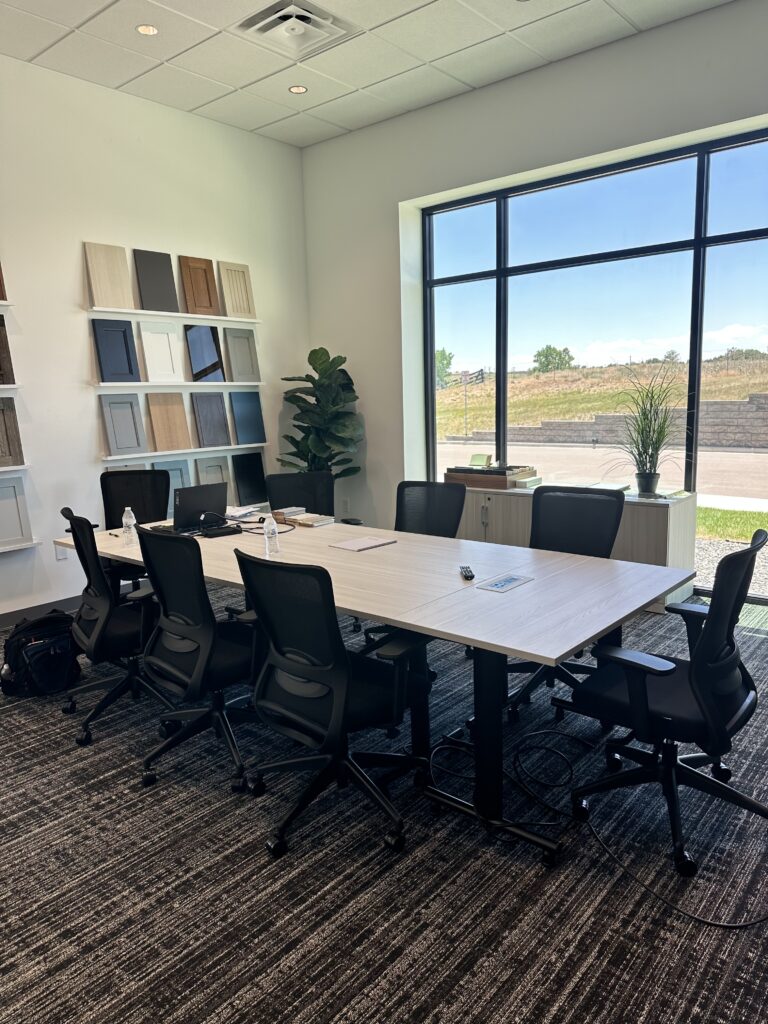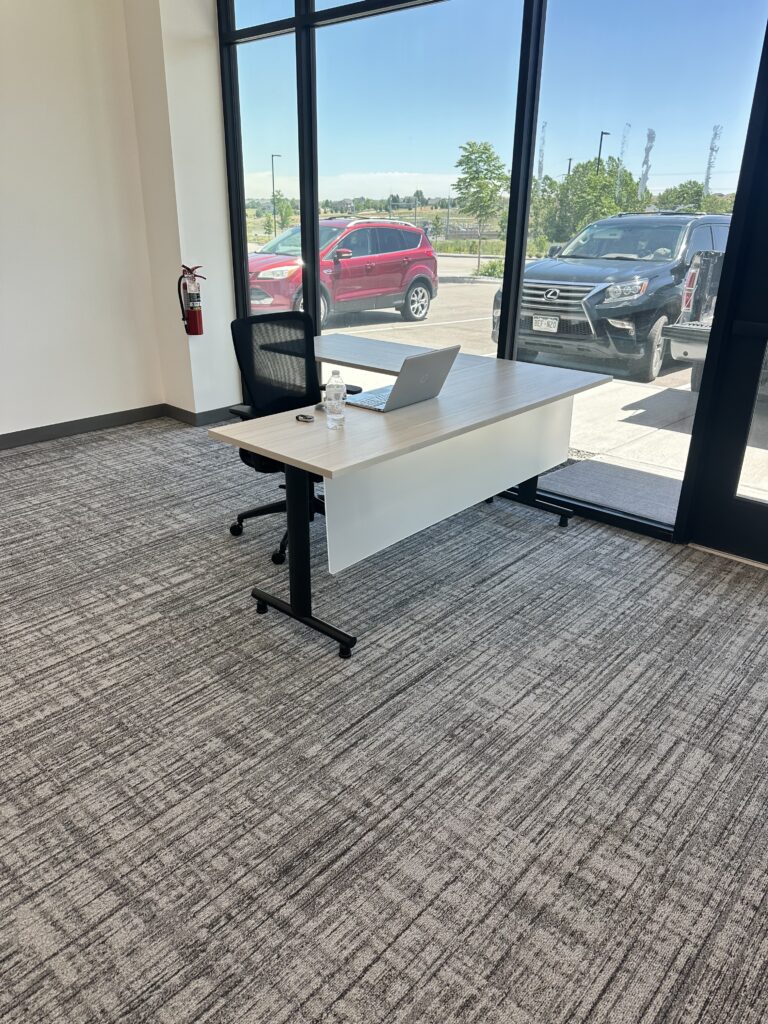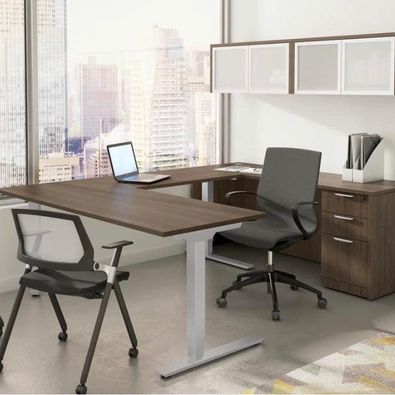Aurora, CO
Office Furniture Aurora
Creating a comfortable workspace can significantly impact employee satisfaction and performance. Selecting the right office furniture is crucial for crafting a functional and inviting workspace. This guide will help you navigate your choices and make well-informed decisions.
- Workplace Environments’
Before a furniture layout is taken into consideration a company must identify the specific functions and tasks within their office to choose appropriate furniture. Below you will find a list of workplace environments:
- Corporate Environments: This traditional work environment consists of designated private offices and cubicles. Traditional conference rooms, training rooms, breakrooms, etc., exist in this type of office environment.
- Touchdown Workplace: Some employers require employees to come into the office daily but do not give their employees a designated desk. The employee comes into the office and finds an empty workstation.
- Collaborative Workplace Environments: These workspaces encourage creativity through an open space plan. Typically, people in the environment prefer sitting in privacy but have height adjustable desks. This way they have the option to stand and collaborate with team members.
- Hybrid Workplace Environment: This type of environment is when employers let their employees work from home part time and the other time they come to the office. Most of these workplace environments have benching or traditional cubicles for everyone besides executives. With the hybrid workplace a company needs to strategically think through what an employee’s workspace will look like since they will only be there part time.
- Embrace Flexibility and Adaptability
In a rapidly changing work environment, versatility is essential:
- Cubicles: Easily reconfigure your space as needed. When working with our team members we will create an existing layout versus a future growth landscape.
- Movable Dividers: Create dynamic spaces for privacy or collaboration. Movable panels are useful for giving team members different types of workplace environments.
- Training Rooms: When designing a training room our goal is to provide clients with 4 to 6 different room configurations. This way the room can host a series of different events.
- Prioritize Health and Comfort
Invest in furniture that promotes well-being and productivity:
- Ergonomic Desk Chairs: Provide lumbar support, seat slider, weight synchro tilt mechanism, will reduce back strain.
- Sit-Stand Desks: Encourage movement and improve posture. Encourage both sitting and standing work positions.
- Adjustable Monitor Arms: Help maintain proper eye levels for monitors will reduce neck strain.
- Anti-Fatigue Mats: Makes it easier on your team members back while they are standing.
- Proper Lighting: Reduce eye strain.
- Integrate with Technology
Ensure your office furniture supports modern technological needs:
- Cable Management Systems: Keep cords organized and out of sight.
- Built-in Power Outlets: Provide convenient access to power and charging.
- Supportive Design: Desks and workstations should accommodate monitors, printers, and other tech equipment. Effective integration of technology minimizes clutter and maximizes productivity.
- Optimize Your Office Layout
Strategically plan your office layout to enhance functionality and flow:
- Floor Plan Analysis: Let one of our Workplace Consultants measure your office to strategically spaceplane your space.
- Accessibility: Make key areas like meeting rooms and break areas for easy access.
- Traffic Flow: Ensure smooth movement around workstations and common areas. A well-designed layout promotes a pleasant and productive working environment.
- Reflect Your Brand Identity
Select office furniture that aligns with your company’s value and image:
- Aesthetics & Design: Choose styles and colors that reflect your brand’s personality.
- Material Quality: High-quality materials reinforce durability along with a professional image. Furniture that embodies your brand can enhance client perceptions and boost employee morale.
- Balance Budget with Value
Find a cost-effective solution that doesn’t compromise on quality:
- Price Comparison: Evaluate different options to get the best value for your budget.
- Long-Term Durability: Invest in office furniture that offers longevity and performance.
- Spend Wisely: Seek discounts or bulk deals from manufacturers who base their pricing on dollars spent. A balanced approach ensures you achieve a durable, functional office within your financial constraints.
- Leverage Local Resources
Working with a local company has the following benefits:
- Personalized Service: Enjoy working with one of our Workplace Consultants from the initial meeting until the office furniture is installed.
- Local: Supporting local businesses can enhance your purchasing experience and contribute to the local economy.
- Customization: Explore bespoke options to meet specific needs and preferences.
Conclusion
Purchasing office furniture can become overwhelming. There are endless options and trying to decide on what would best fit your organization can become complicated. Let one of our Workplace Consultants assist you create a thoughtful approach to defining needs, ensuring flexibility, prioritizing health, and integrating technology. By focusing on these aspects and utilizing Denver Office Furniture’s resources, you can create a workspace that enhances productivity and aligns with your company’s vision. Let our team lead you through a journey of thoughtful selection and strategic planning. This will lead to a well-designed office that fosters a positive and efficient work environment.




